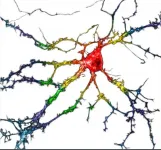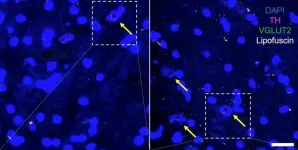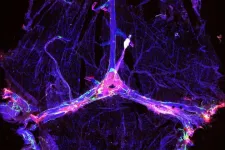(Press-News.org) A genetically encoded sensor to detect hallucinogenic compounds has been developed by researchers at the University of California, Davis. Named psychLight, the sensor could be used in discovering new treatments for mental illness, in neuroscience research and to detect drugs of abuse. The work is published April 28 in the journal Cell.
Compounds related to psychedelic drugs such as LSD and dimethyltryptamine (DMT) show great promise for treating disorders such as depression, post-traumatic stress disorder, and substance use disorder. These drugs are called psychoplastogens because of their ability to rapidly alter brain connections. But drugs that can cause hallucinations require very careful use and monitoring of patients.
Currently, the most effective way to test an experimental drug to see if it causes hallucinations is the "head twitch" assay in rodents.
"Scientific studies on psychedelic drugs have been conducted since the 1940s, but we still don't have an effective cellular assay for them," said David Olson, assistant professor in the Department of Chemistry, College of Letters and Science at UC Davis and a co-author on the paper.
The work grew out of collaboration between graduate students working with Lin Tian, associate professor at the UC Davis School of Medicine, and Olson's laboratory.
"This collaboration was really driven by graduate students," Tian said.
Tian's lab develops fluorescent indicators for neural chemicals in the brain such as serotonin and dopamine. These neuromodulators allow the brain to react quickly to changing conditions, Tian said. Like neuromodulators, both psychedelic drugs and those used to treat mental illness either mimic or block the action of these neuromodulators, thus can have profound impacts on brain function.
Measuring chemicals in the brain
The psychLight biosensor is based on the serotonin 2A receptor (HT2AR). Within the brain, serotonin released from neurons and picked up by serotonin receptors on other neurons acts to regulate mood. Both psychedelic drugs and drugs used to treat psychiatric disorders act through the serotonin 2A receptor.
Jason (Chunyang) Dong, a graduate student in Tian's lab in the Department of Biochemistry and Molecular Biology, worked with graduate students Calvin Ly and Lee Dunlap in Olson's lab to engineer a modified version of the HT2A receptor with a fluorescent component. When psychLight binds to serotonin or a hallucinogenic ligand it changes its conformation, causing the fluorescence to increase. Non-hallucinogenic ligands can also bind to psychLight but lead to a different fluorescence profile.
Researchers can use psychLight to see how naturally occurring neuromodulators like serotonin, or hallucinogenic drugs, act on different parts of the brain. They could also use it to screen candidate drugs for those which activate the HT2A receptor and could cause hallucinations. When psychLight is expressed in cells and those cell cultures are exposed to a hallucinogenic drug, they light up.
The sensor can be used to look for pharmaceutical potential without the side effect of hallucinations, Tian said.
High-throughput screening
The researchers set up a high-throughput system to use cells expressing psychLight to screen compounds for hallucinogenic activity and for binding of the HT2A receptor. Using this, they showed that a previously untested compound, AAZ-A-154, activates the receptor but is not hallucinogenic. Subsequent tests in animal models confirmed that AAZ-A-154 shows promise as an antidepressant.
Seven Biosciences, a company founded by Tian and former graduate student Grace Mizuno, is working with UC Davis InnovationAccess to license the psychLight technology and develop it for commercial use. Delix Therapeutics, founded by Olson, is developing AAZ-A-154 and hopes to apply the psychLight assay to search for new pharmaceutical drugs.
INFORMATION:
Additional authors on the Cell paper are: Maxemiliano Vargas, Junqing Sun, and Arya Azinfar at UC Davis; Won Chan Oh and In-Wook Wang at University of Colorado; and William Wetsel at Duke University. The work was supported by grants from the National Institutes of Health, a Hellman Fellowship, and the UC Davis STAIR grant program.
Article: Dong et al., "Psychedelic-inspired drug discovery using an engineered biosensor," Cell, doi:10.1016/j.cell.2021.03.043
It's one of the most audacious projects in biology today - reading the entire genome of every bird, mammal, lizard, fish, and all other creatures with backbones.
And now comes the first major payoff from the Vertebrate Genome Project (VGP): near complete, high-quality genomes of 25 species, Howard Hughes Medical Institute (HHMI) Investigator Erich Jarvis with scores of coauthors report April 28, 2021, in the journal Nature. These species include the greater horseshoe bat, the Canada lynx, the platypus, and the kākāp? parrot - one of the first high-quality ...
Researchers have big ideas for the potential of quantum technology, from unhackable networks to earthquake sensors. But all these things depend on a major technological feat: being able to build and control systems of quantum particles, which are among the smallest objects in the universe.
That goal is now a step closer with the publication of a new method by University of Chicago scientists. Published April 28 in Nature, the paper shows how to bring multiple molecules at once into a single quantum state--one of the most important goals in quantum physics.
"People have been trying to do this for decades, so we're very excited," said senior author Cheng Chin, a professor of physics at UChicago who said he has wanted ...
PITTSBURGH, April 28, 2021 - It is not every day that scientists come across a phenomenon so fundamental that it is observed across fruit flies, rodents and humans.
In a paper published today in Aging Cell, neuroscientists from the University of Pittsburgh Schools of the Health Sciences discovered that a single protein--a glutamate transporter on the membrane of vesicles that carry dopamine in neurons--is key to regulating sex differences in the brain's vulnerability to age-related neuron loss.
The protein--named VGLUT--was more abundant in dopamine neurons of female fruit flies, rodents and human beings than in males, correlating with females' greater resilience to age-related neuron loss and mobility deficiencies, the researchers found. Excitingly, ...
DURHAM, N.C. -- A multidecade study of young adults living in the United Kingdom has found higher rates of mental illness symptoms among those exposed to higher levels of traffic-related air pollutants, particularly nitrogen oxides, during childhood and adolescence.
Previous studies have identified a link between air pollution and the risk of specific mental disorders, including depression and anxiety, but this study looked at changes in mental health that span all forms of disorder and psychological distress associated with exposure to traffic-related air pollutants.
The findings, which will appear April ...
Experimental Alzheimer's drugs have shown little success in slowing declines in memory and thinking, leaving scientists searching for explanations. But new research in mice has shown that some investigational Alzheimer's therapies are more effective when paired with a treatment geared toward improving drainage of fluid -- and debris -- from the brain, according to a study led by researchers at Washington University School of Medicine in St. Louis.
The findings, published April 28 in the journal Nature, suggest that the brain's drainage system -- known as the meningeal lymphatics -- plays a pivotal but underappreciated role in neurodegenerative disease, and that repairing faulty drains could be a key to unlocking the potential of certain Alzheimer's therapies.
"The ...
Is forest harvesting increasing in Europe? Yes, but not as much as reported last July in a controversial study published in Nature.
The study Abrupt increase in harvested forest area over Europe after 2015, used satellite data to assess forest cover and claimed an abrupt increase of 69% in the harvested forest in Europe from 2016. The authors, from the European Commission's Joint Research Centre (JRC), suggested that this increase resulted from expanding wood markets encouraged by EU bioeconomy and bioenergy policies. The publication triggered a heated debate, both scientific ...
What The Study Did: Length, readability and complexity of informed consent documents for the COVID-19 vaccine phase III randomized clinical trials were assessed in this quality improvement study.
Authors: Ezekiel J. Emanuel, M.D., Ph.D., of the University of Pennsylvania in Philadelphia, is the corresponding author.
To access the embargoed study: Visit our For The Media website at this link https://media.jamanetwork.com/
(doi:10.1001/jamanetworkopen.2021.10843)
Editor's Note: The article includes conflict of interest and funding/support disclosures. Please see the article for additional information, including other authors, author ...
What The Study Did: The number of applicants and number of applications submitted per applicant to internal medicine residency and subspecialty fellowships for 2021 during the COVID-19 pandemic were compared with five prior application cycles in this study.
Authors: Laura A. Huppert, M.D., of the University of California, San Francisco, is the corresponding author.
To access the embargoed study: Visit our For The Media website at this link https://media.jamanetwork.com/
(doi:10.1001/jamanetworkopen.2021.8199)
Editor's Note: The article includes ...
What The Study Did: Researchers evaluated racial/ethnic differences in the performance of statistical models that use health record data to predict the risk of suicide after an outpatient mental health visit.
Authors: R. Yates Coley, Ph.D., of the Kaiser Permanente Washington Health Research Institute in Seattle, is the corresponding author.
To access the embargoed study: Visit our For The Media website at this link https://media.jamanetwork.com/
(10.1001/jamapsychiatry.2021.0493)
Editor's Note: The article includes conflict of interest and funding/support disclosures. Please see the article for additional information, including other authors, author contributions and affiliations, conflict of interest ...
What The Study Did: The association between undergoing gender-affirming surgery and mental health outcomes was looked at in this study.
Authors: Anthony N. Almazan, B.A., of Harvard Medical School in Boston, is the corresponding author.
To access the embargoed study: Visit our For The Media website at this link https://media.jamanetwork.com/
(doi:10.1001/jamasurg.2021.0952)
Editor's Note: The article includes conflict of interest and funding/support disclosures. Please see the article for additional information, including other authors, author contributions and affiliations, conflict of interest and financial disclosures, and funding and support.
INFORMATION:
Media advisory: The full study and commentary ...



